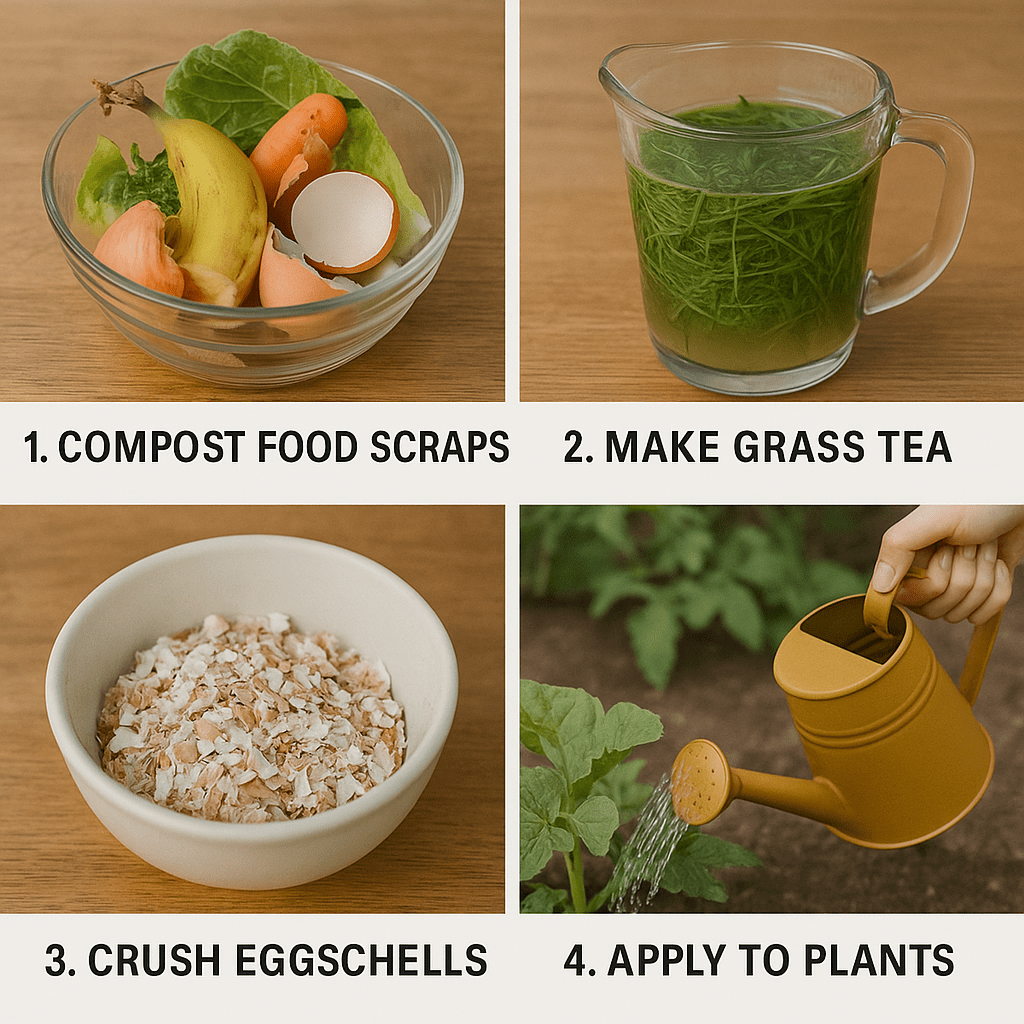Using the best natural fertilizers you can make at home is an excellent way to boost your garden’s health while saving money and reducing waste. Whether you’re growing vegetables, flowers, or houseplants, homemade fertilizers provide vital nutrients and improve soil structure without harmful chemicals.
In this article, you’ll discover the most effective DIY fertilizers, how to prepare them, when to use each type, and tips to maximize their benefits.
Why Use Natural Fertilizers?
Natural fertilizers are derived from organic matter and contain essential nutrients like nitrogen (N), phosphorus (P), and potassium (K), along with trace minerals. They not only feed your plants but also promote soil health.
Benefits of Homemade Fertilizers:
- Eco-friendly: Reduce reliance on synthetic products.
- Low-cost or free: Use kitchen scraps and yard waste.
- Soil enrichment: Improve texture, water retention, and microbial activity.
- Safe for pollinators and pets: No toxic residues.
Top 7 Natural Fertilizers You Can Make at Home
1. Compost
What it is: Decomposed kitchen and garden waste.
How to make it:
- Collect fruit peels, vegetable scraps, eggshells, coffee grounds, and garden trimmings.
- Avoid meat, dairy, and oily foods.
- Layer green (wet) and brown (dry) materials in a bin or pile.
- Turn weekly to aerate and speed up decomposition.
How to use: Mix into garden beds or top-dress around plants.
2. Banana Peel Fertilizer
What it is: Rich in potassium and phosphorus.
How to make it:
- Chop banana peels and bury them near plant roots.
- For liquid fertilizer: Soak peels in water for 3–5 days.
Best for: Flowering plants, tomatoes, peppers, and roses.
3. Eggshell Powder
What it is: A natural source of calcium.
How to make it:
- Rinse eggshells and allow to dry.
- Crush them into a fine powder using a blender or mortar and pestle.
How to use: Sprinkle directly into soil or mix into compost.
4. Used Coffee Grounds
What it is: Contains nitrogen, magnesium, and improves soil structure.
How to make it:
- Collect used grounds and allow to dry.
- Mix with soil or compost.
Best for: Acid-loving plants like blueberries, azaleas, and hydrangeas.
5. Grass Clipping Tea
What it is: High in nitrogen.
How to make it:
- Fill a 5-gallon bucket with fresh grass clippings.
- Cover with water and let sit for 3–5 days.
- Stir occasionally.
How to use: Dilute the strained liquid 1:1 with water and pour at plant base.
6. Epsom Salt Solution
What it is: Provides magnesium and sulfur.
How to make it:
- Mix 1 tablespoon of Epsom salt per gallon of water.
Best for: Tomatoes, peppers, and leafy greens.
7. Aquarium Water
What it is: Fish waste water full of beneficial nutrients.
How to use: Use untreated (non-salted) aquarium water to water your plants directly.

When and How Often to Fertilize Naturally
The frequency of application depends on the type of fertilizer and the plant’s stage of growth:
| Fertilizer Type | Frequency | Notes |
|---|---|---|
| Compost | Monthly | Top-dress or mix into soil |
| Banana Peel Water | Every 2 weeks | Especially during flowering stage |
| Eggshell Powder | Monthly | Great for preventing blossom end rot |
| Coffee Grounds | Weekly or Biweekly | Mix into soil lightly |
| Grass Clipping Tea | Every 2 weeks | Use in early growing phase |
| Epsom Salt Solution | Monthly | Avoid overuse to prevent salt buildup |
| Aquarium Water | As needed | Use only if water is chemical-free |
Tips for Better Results
- Test your soil: Know what nutrients your garden needs.
- Avoid overfeeding: Even natural fertilizers can be overapplied.
- Rotate applications: Combine different fertilizers throughout the season.
- Observe plant response: Adjust based on how your plants react.
Where to Get the Right Tools
Looking to compost effectively at home? You can find compact compost bins and gardening tools at Gardener’s Supply Company.
Internal Resource
Want to ensure your plants are properly hydrated before applying fertilizer? Read our complete guide on watering plants correctly.
Conclusion: Boost Your Garden Naturally
By using the best natural fertilizers you can make at home, you support a healthier environment, save money, and enjoy stronger, more vibrant plants. Whether you’re composting or brewing grass tea, every step helps your garden thrive.
🌿 Save this guide for your next planting weekend!
🌼 Share it with a friend who loves gardening naturally!
FAQ – Natural Fertilizers
Can I mix natural fertilizers together?
Yes, combining compost with other fertilizers like eggshell powder or coffee grounds can create a balanced nutrient blend. Just be sure not to overdo it.
How long does it take to see results?
Most homemade fertilizers begin working within 1–2 weeks, but improvements in plant growth may take longer depending on the plant and soil conditions.
Are natural fertilizers safe for indoor plants?
Absolutely! Just be cautious with odors or overwatering when using compost tea or banana peel soaks indoors.
Written by Kate Smith | Plant Care Enthusiast & Urban Gardener
